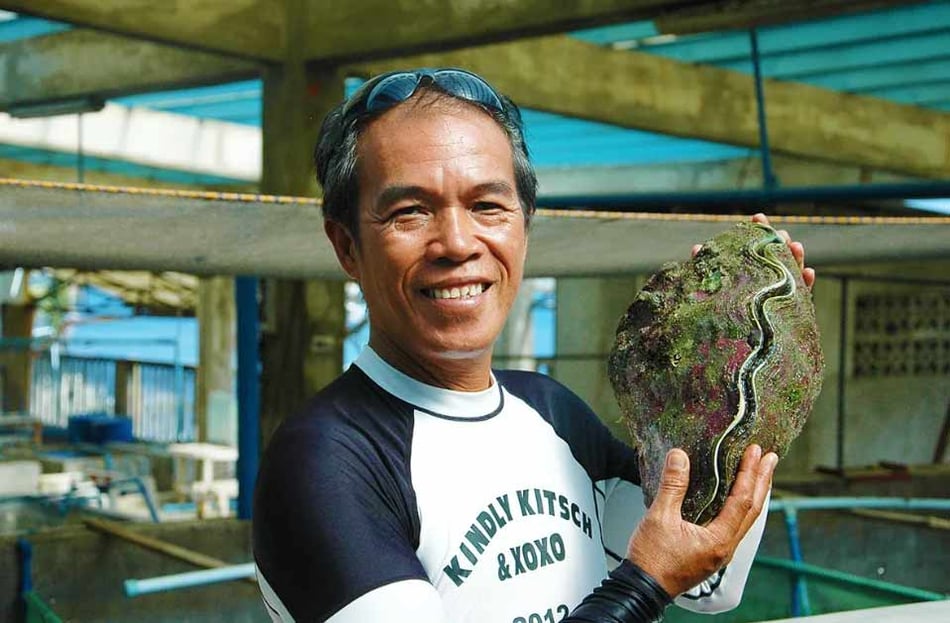Colossal Clam Comeback: Revitalizing the Giant Clam Population in the Philippines

Tin
2
min. read

The marine life of the Philippines includes an organism that is both a remarkable marvel of nature and a vital part of the marine ecosystem. This creature is none other than the giant clam, the largest living bivalve mollusk, capable of reaching up to 1.5 meters and 250 kg in size!
Giant clams perform an essential role in maintaining the health and vibrancy of coral reef ecosystems. Their symbiotic relationship with a type of algae, known as zooxanthellae, is a prime example of this. In this mutually beneficial relationship, the clam offers the algae a safe home, while the algae reciprocate by supplying the clam with nutrients necessary for growth. In fact, giant clams are only able to grow at the rate that they do because of zooxanthellae. This is much the same as coral reefs, which also are only able to grow so large because of these very same algae. Additionally, both giant clam shells and coral reefs function as microhabitats for a wide array of smaller marine organisms, providing them with food, shelter, and protection. While coral reefs essentially create marine ecosystems, giant clams act as micro-ecosystems within the larger marine habitat, further fostering marine biodiversity.

Photo taken from a Business Mirrror article on UP-MSI’s work with Giant Clams
Despite their significant ecological role, the survival of giant clams has been under threat due to factors such as overfishing, pollution, and habitat destruction. In response, multiple conservation initiatives have sprung up to restore the giant clam population. In particular, WorldFish Center and the Australian Centre for International Agricultural Research (ACIAR) organized a regional collaborative research program centered on these clams.
The Marine Science Institute (MSI) of the University of the Philippines also played a pivotal role in this ambitious endeavor: they adopted and implemented advanced methods based on established protocols for the effective breeding of giant clams. This involved the nurturing of young clams in a controlled environment, followed by their careful reintroduction into the wild. Over two decades, MSI successfully conducted spawning trials with various clam species. Even when ACIAR's funding concluded, the MSI continued its work in this area with support from the International Development Research Centre (IDRC) of Canada. They focused on large-scale production for restocking and creating livelihood opportunities for local communities.
The efforts of academic institutions such as those of MSI have shown us that every little bit helps. The success of the restocking program for giant clams in the Philippines has shown that it is indeed possible to reverse the effects of human-induced harm to marine life, with human-induced solutions. It sets a powerful example for other conservation efforts globally and serves as a testament to what collaborative efforts can achieve.
As a part of this drive towards solutions and away from repeating "doom and gloom" rhetoric, IMARCS endeavors to provide a beacon of hope for marine conservation. IMARCS is guided by a mission to reduce atmospheric CO2, restore marine ecosystems, and strengthen local communities - and a vision where we participate in collective efforts towards a sustainable and prosperous future, with our actions directly benefitting the health of our oceans and our communities.

UP MSI-BML giant clams administrative aide Julio Curiano Jr. holds a Tridacna derasa straight out of the ocean nursery.
Sources:
Gomez, E. D., & Mingoa-Licuanan, S. S. (2006, August). Achievements and lessons learned in restocking giant clams in the Philippines. Fisheries Research, 80(1), 46–52.
Neo, M. L., Eckman, W., Vicentuan, K., Teo, S. L. M., & Todd, P. A. (2015, January). The ecological significance of giant clams in coral reef ecosystems. Biological Conservation, 181, 111–123.
Meet the giant clam fam. (2018, June 22). University of the Philippines. https://up.edu.ph/meet-the-giant-clam-fam/
Abad, R. (2021, June 19). Keeping giant clams to sustain PHL marine ecosystem | Roderick Abad. BusinessMirror. https://businessmirror.com.ph/2021/06/20/keeping-giant-clams-to-sustain-phl-marine-ecosystem/